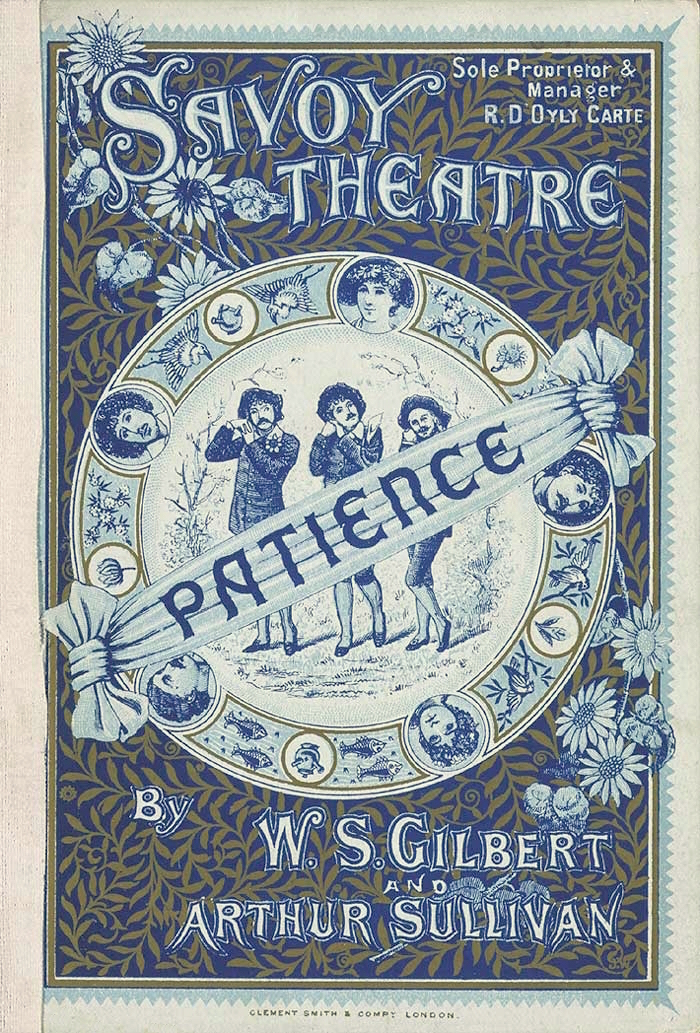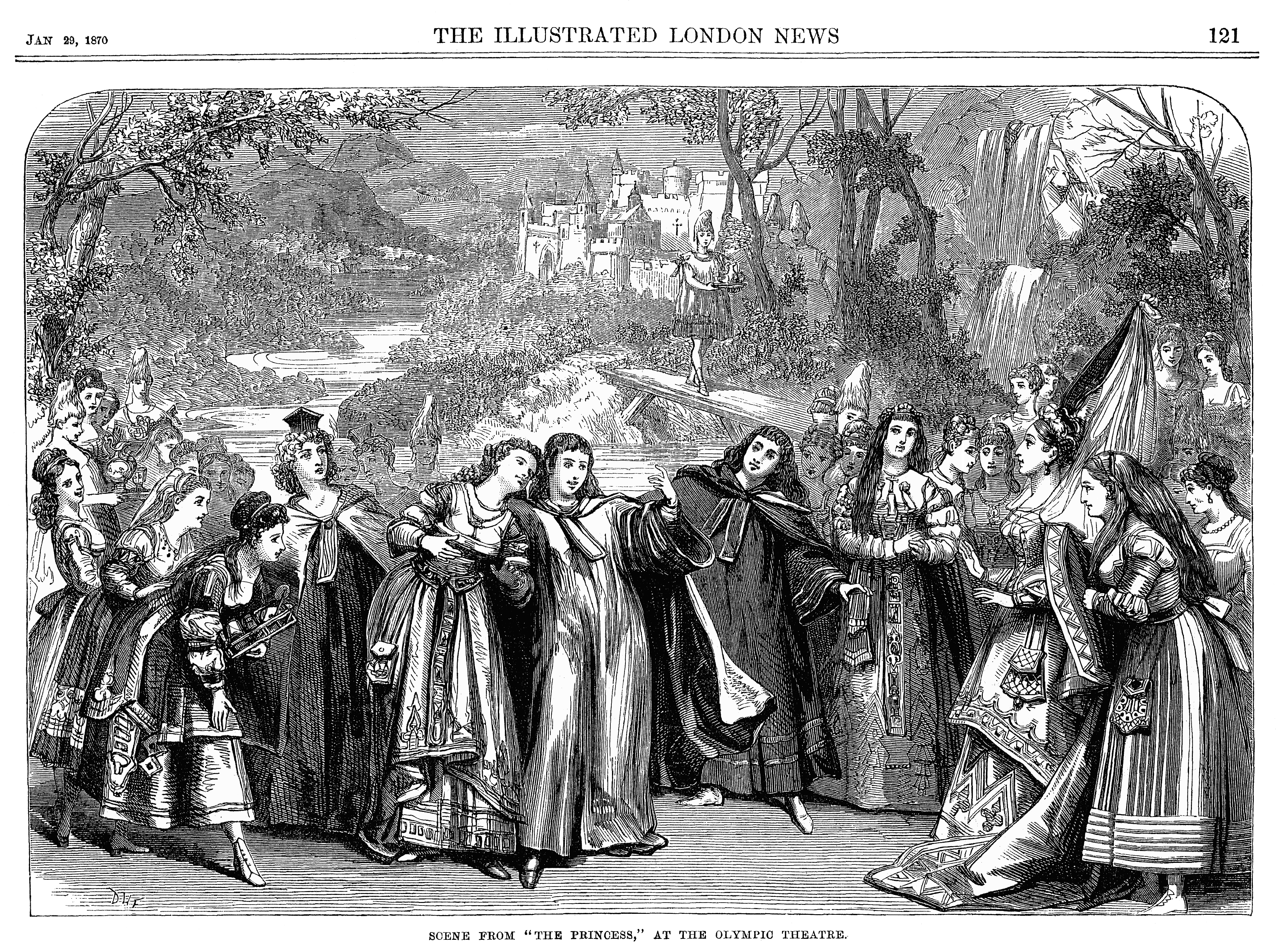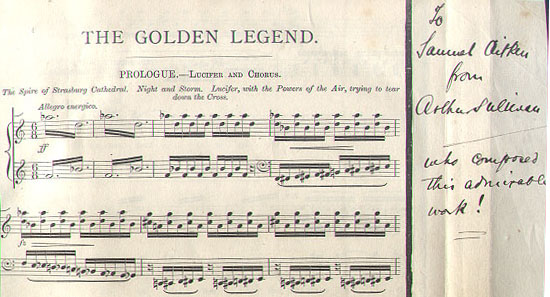|
Ruddygore
''Ruddigore; or, The Witch's Curse'', originally called ''Ruddygore'', is a comic opera in two acts, with music by Arthur Sullivan and libretto by W. S. Gilbert. It is one of the Savoy Operas and the tenth of fourteen comic operas written together by Gilbert and Sullivan. It was first performed by the D'Oyly Carte Opera Company at the Savoy Theatre in London on 22 January 1887. The first night was not altogether a success, as critics and the audience felt that ''Ruddygore'' (as it was originally spelled) did not measure up to its predecessor, ''The Mikado''. After some changes, including respelling the title, it achieved a run of 288 performances. The piece was profitable, and the reviews were not all bad. For instance, the ''Illustrated London News'' praised the work of both Gilbert and, especially, Sullivan: "Sir Arthur Sullivan has eminently succeeded alike in the expression of refined sentiment and comic humour. In the former respect, the charm of graceful melody prevai ... [...More Info...] [...Related Items...] OR: [Wikipedia] [Google] [Baidu] |
Gilbert And Sullivan
Gilbert and Sullivan was a Victorian era, Victorian-era theatrical partnership of the dramatist W. S. Gilbert (1836–1911) and the composer Arthur Sullivan (1842–1900), who jointly created fourteen comic operas between 1871 and 1896, of which ''H.M.S. Pinafore'', ''The Pirates of Penzance'' and ''The Mikado'' are among the best known.Davis, Peter G''Smooth Sailing'' ''New York'' magazine, 21 January 2002, accessed 6 November 2007 Gilbert, who wrote the libretti for these operas, created fanciful "topsy-turvy" worlds where each absurdity is taken to its logical conclusion; fairies rub elbows with British lords, flirting is a capital offence, gondoliers ascend to the monarchy, and pirates emerge as noblemen who have gone astray.Mike Leigh, Leigh, Mike"True anarchists" ''The Guardian'', 4 November 2007, accessed 6 November 2007 Sullivan, six years Gilbert's junior, composed the music, contributing memorable melodies that could convey both humour and pathos. Their operas have enj ... [...More Info...] [...Related Items...] OR: [Wikipedia] [Google] [Baidu] |
Savoy Opera
Savoy opera was a style of comic opera that developed in Victorian England in the late 19th century, with W. S. Gilbert and Arthur Sullivan as the original and most successful practitioners. The name is derived from the Savoy Theatre, which impresario Richard D'Oyly Carte built to house the Gilbert and Sullivan pieces, and later those by other composer–librettist teams. The great bulk of the non-G&S Savoy Operas either failed to achieve a foothold in the standard repertory, or have faded over the years, leaving the term "Savoy Opera" as practically synonymous with Gilbert and Sullivan. The Savoy operas (in both senses) were seminal influences on the creation of the modern musical. Gilbert, Sullivan, Carte and other Victorian era British composers, librettists and producers, as well as the contemporary British press and literature, called works of this kind "comic operas" to distinguish their content and style from that of the often risqué continental European operettas that th ... [...More Info...] [...Related Items...] OR: [Wikipedia] [Google] [Baidu] |
Comic Opera
Comic opera, sometimes known as light opera, is a sung dramatic work of a light or comic nature, usually with a happy ending and often including spoken dialogue. Forms of comic opera first developed in late 17th-century Italy. By the 1730s, a new operatic genre, ''opera buffa'', emerged as an alternative to '' opera seria''. It quickly made its way to France, where it became ''opéra comique'', and eventually, in the following century, French operetta, with Jacques Offenbach as its most accomplished practitioner. The influence of the Italian and French forms spread to other parts of Europe. Many countries developed their own genres of comic opera, incorporating the Italian and French models along with their own musical traditions. Examples include German ''singspiel'', Viennese operetta, Spanish '' zarzuela'', Russian comic opera, English ballad and Savoy opera, North American operetta and musical comedy. Italian ''opera buffa'' In late 17th-century Italy, light-hearted m ... [...More Info...] [...Related Items...] OR: [Wikipedia] [Google] [Baidu] |
West Yorkshire
West Yorkshire is a metropolitan and ceremonial county in the Yorkshire and Humber Region of England. It is an inland and upland county having eastward-draining valleys while taking in the moors of the Pennines. West Yorkshire came into existence as a metropolitan county in 1974 after the reorganisation of the Local Government Act 1972 which saw it formed from a large part of the West Riding of Yorkshire. The county had a recorded population of 2.3 million in the 2011 Census making it the fourth-largest by population in England. The largest towns are Huddersfield, Castleford, Batley, Bingley, Pontefract, Halifax, Brighouse, Keighley, Pudsey, Morley and Dewsbury. The three cities of West Yorkshire are Bradford, Leeds and Wakefield. West Yorkshire consists of five metropolitan boroughs (City of Bradford, Calderdale, Kirklees, City of Leeds and City of Wakefield); it is bordered by the counties of Derbyshire to the south, Greater Manchester to the south-west, Lancash ... [...More Info...] [...Related Items...] OR: [Wikipedia] [Google] [Baidu] |
The Crystal Palace
The Crystal Palace was a cast iron and plate glass structure, originally built in Hyde Park, London, Hyde Park, London, to house the Great Exhibition of 1851. The exhibition took place from 1 May to 15 October 1851, and more than 14,000 exhibitors from around the world gathered in its exhibition space to display examples of technology developed in the Industrial Revolution. Designed by Joseph Paxton, the Great Exhibition building was long, with an interior height of , and was three times the size of St Paul's Cathedral. The introduction of the sheet glass method into Britain by Chance Brothers in 1832 made possible the production of large sheets of cheap but strong glass, and its use in the Crystal Palace created a structure with the greatest area of glass ever seen in a building. It astonished visitors with its clear walls and ceilings that did not require interior lights. It has been suggested that the name of the building resulted from a piece penned by the playwright Doug ... [...More Info...] [...Related Items...] OR: [Wikipedia] [Google] [Baidu] |
Princess Ida
''Princess Ida; or, Castle Adamant'' is a comic opera with music by Arthur Sullivan and libretto by W. S. Gilbert. It was their eighth operatic collaboration of fourteen. ''Princess Ida'' opened at the Savoy Theatre on 5 January 1884, for a run of 246 performances. The piece concerns a princess who founds a women's university and teaches that women are superior to men and should rule in their stead. The prince to whom she had been married in infancy sneaks into the university, together with two friends, with the aim of collecting his bride. They disguise themselves as women students, but are discovered, and all soon face a literal war between the sexes. The opera satirizes feminism, women's college, women's education and Charles Darwin, Darwinian evolution, which were controversial topics in conservative Victorian era, Victorian England. ''Princess Ida'' is based on a narrative poem by Alfred, Lord Tennyson called ''The Princess (Tennyson poem), The Princess'' (1847), and Gilb ... [...More Info...] [...Related Items...] OR: [Wikipedia] [Google] [Baidu] |
Fanny Ronalds
Mary Frances Ronalds RRC DStJ (née Carter; August 23, 1839 – July 28, 1916) was an American socialite and amateur singer who is best known for her long affair with the composer Arthur Sullivan in London in the last decades of the nineteenth century and for her musical salons. After separating from her husband, Ronalds moved with her children from New York to Paris in 1867, then to Tunis in 1869, and eventually to London in 1875. She was accepted into royal social circles and was a popular hostess. A noted beauty, she became romantically involved with Arthur Sullivan during the 1870s and continued as his companion until his death in 1900. She was much admired as a singer and became famously associated with one of Sullivan's most popular songs, "The Lost Chord". Early life Ronalds, generally called "Fanny", was born in Boston, Massachusetts, the daughter of Joseph Ballard Carter (1813–1889) and his wife,Ainger, p. 129 Mary ( née Chamberlain) Carter (died 1898). In 1859 a ... [...More Info...] [...Related Items...] OR: [Wikipedia] [Google] [Baidu] |
Leeds Festival (classical Music)
The Leeds Festival, officially known as the ''Leeds Triennial Musical Festival'', was a classical music festival which took place between 1858 and 1985 in Leeds, West Yorkshire, England. History The first festival celebrated the opening of Leeds Town Hall by Queen Victoria on 7 September 1858. A second festival was held in 1874, then it was held every three years until 1970. For the two festivals in the 1870s, Sir Michael Costa was principal conductor. For the next seven festivals, until 1898, the principal conductor was Sir Arthur Sullivan. King George V was the festival's patron in 1922; his daughter, The Princess Royal, sister of King George VI, and her husband also became patrons in anticipation of their wedding in 1922. From the 1920s, Princess Mary had attended the opening nights and many of the festival's performances, and later, with her son, George Lascelles, 7th Earl of Harewood, and his wife, the Countess of Harewood, née Marion Stein, a former concert pianist. L ... [...More Info...] [...Related Items...] OR: [Wikipedia] [Google] [Baidu] |
The Golden Legend (cantata)
''The Golden Legend'' is an 1886 cantata by Arthur Sullivan with libretto by Joseph Bennett, based on the 1851 poem of the same name by Henry Wadsworth Longfellow. The piece premiered at the triennial Leeds Music Festival. At least 17 performances of the cantata were given in Britain during the first year after its premiere in October 1886, and during Sullivan's lifetime it was widely considered his greatest and most successful work of serious music. Indeed, outside of the comic operas with W. S. Gilbert, this cantata was widely regarded as Sullivan's most successful large-scale composition. A few days after the first performance, Gilbert wrote to Sullivan, "I congratulate you heartily on the success of the Cantata which appears from all accounts to be the biggest thing you've done." In May 1888, there was a performance of the work at the Royal Albert Hall by command of Queen Victoria. She sent for Sullivan after the performance and said, "At last I have heard ''The Golden Le ... [...More Info...] [...Related Items...] OR: [Wikipedia] [Google] [Baidu] |
Cantata
A cantata (; ; literally "sung", past participle feminine singular of the Italian verb ''cantare'', "to sing") is a vocal composition with an instrumental accompaniment, typically in several movements, often involving a choir. The meaning of the term changed over time, from the simple single-voice madrigal of the early 17th century, to the multi-voice "cantata da camera" and the "cantata da chiesa" of the later part of that century, from the more substantial dramatic forms of the 18th century to the usually sacred-texted 19th-century cantata, which was effectively a type of short oratorio. Cantatas for use in the liturgy of church services are called church cantata or sacred cantata; other cantatas can be indicated as secular cantatas. Several cantatas were, and still are, written for special occasions, such as Christmas cantatas. Christoph Graupner, Georg Philipp Telemann and Johann Sebastian Bach composed cycles of church cantatas for the occasions of the liturgical year. ... [...More Info...] [...Related Items...] OR: [Wikipedia] [Google] [Baidu] |
Family Curse
A curse (also called an imprecation, malediction, execration, malison, anathema, or commination) is any expressed wish that some form of adversity or misfortune will befall or attach to one or more persons, a place, or an object. In particular, "curse" may refer to such a wish or pronouncement made effective by a supernatural or spiritual power, such as a god or gods, a spirit, or a natural force, or else as a kind of spell by magic (usually black magic) or witchcraft; in the latter sense, a curse can also be called a hex or a jinx. In many belief systems, the curse itself (or accompanying ritual) is considered to have some causative force in the result. To reverse or eliminate a curse is sometimes called "removal" or "breaking", as the spell has to be dispelled, and often requires elaborate rituals or prayers. Types The study of the forms of curses comprises a significant proportion of the study of both folk religion and folklore. The deliberate attempt to levy curses is o ... [...More Info...] [...Related Items...] OR: [Wikipedia] [Google] [Baidu] |
Adelphi Theatre
The Adelphi Theatre is a West End theatre, located on the Strand in the City of Westminster, central London. The present building is the fourth on the site. The theatre has specialised in comedy and musical theatre, and today it is a receiving house for a variety of productions, including many musicals. The theatre was Grade II listed for historical preservation on 1 December 1987. History 19th century It was founded in 1806 as the Sans Pareil ("Without Compare"), by merchant John Scott, and his daughter Jane (1770–1839). Jane was a British theatre manager, performer, and playwright. Together, they gathered a theatrical company and by 1809 the theatre was licensed for musical entertainments, pantomime, and burletta. She wrote more than fifty stage pieces in an array of genres: melodramas, pantomimes, farces, comic operettas, historical dramas, and adaptations, as well as translations. Jane Scott retired to Surrey in 1819, marrying John Davies Middleton (1790–186 ... [...More Info...] [...Related Items...] OR: [Wikipedia] [Google] [Baidu] |

.jpg)







